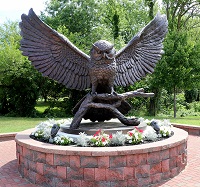Date Approved
1-28-2025
Embargo Period
3-17-2026
Document Type
Dissertation
Degree Name
Doctor of Philosophy (Ph.D.)
Department
Cell Biology and Neuroscience
College
Rowan-Virtua School of Translational Biomedical Engineering & Sciences
Advisor
Daniel Manvich, PhD
Committee Member 1
Elizabeth West-Niedringhaus, PhD
Committee Member 2
Jessica Loweth, PhD
Committee Member 3
Daniel Chandler, PhD
Committee Member 4
Jesse Schank, PhD
Keywords
cocaine;Hypothalamic defense network;lateral hypothalamus;periaqueductal gray;prefrontal cortex;psycosocial stress
Disciplines
Medical Sciences | Medicine and Health Sciences | Neurosciences
Abstract
Abstract Nicole Maria Hinds BEHAVIORAL AND NEUROACTIVATIONAL CORRELATES OF PSYCHOSOCIAL STRESS-INDUCED COCAINE SEEKING IN THE RAT 2024 Molecular Cell Biology & Neuroscience Doctor of Philosophy Cocaine Use Disorder is characterized by a high risk for relapse that can persist over extended periods of abstinence. Psychosocial stressors are well-established to promote drug craving and relapse in humans but have rarely been employed in preclinical relapse models. Consequently, the underlying neural circuitry by which these stressors drive cocaine seeking has not yet been thoroughly explored. This project aimed to identify brain regions recruited during psychosocial stress-induced cocaine seeking in rats, with a focus on the ventromedial hypothalamus and periaqueductal gray, two critical components of the brain’s medial hypothalamic defense network. Male and female Long-Evans rats were trained to self-administer cocaine (0.5 mg/kg/inf, IV) in 2-h daily sessions for 20 sessions. On sessions 11, 14, 17, and 20, a discrete tactile cue was presented in the operant chamber that signaled impending social defeat stress, nonsocial footshock stress, or a no-stress control condition, each in separate groups of rats. Responding was then extinguished, and rats were then either re-exposed to the cue that signaled their assigned stress/no-stress post session event, or subjected to another extinction session, and reinstatement of cocaine seeking was measured. Immunohistochemical detection of c-Fos expression was then employed to examine patterns of neural activation in brain regions of interest that coincided with cocaine-seeking behavior. Re-exposure to the tactile cue reinstated cocaine seeking in both males and females in all groups. Moreover, predilection to display active-defense coping strategies during social threat was positively correlated with cocaine-seeking magnitude. Neuronal activation of the rostrolateral periaqueductal gray (rPAGl) during psychosocial stress-induced cocaine seeking was significantly and positively correlated with the tendency to display active-defense coping responses during social defeat stress and with psychosocial stress-induced cocaine-seeking behavior, as well as with levels of neural activation in the prelimbic prefrontal cortex and lateral hypothalamus/perifornical area, associations that were driven by males. Finally, retrograde tract-tracing studies revealed a negative correlation between psychosocial stress-induced cocaine seeking and the number of rPAGl/vl-projecting cells in the prelimbic prefrontal cortex and anterior cingulate cortex, including the subpopulation of these cells that were Fos-positive. Collectively, these results indicate for the first time that the rPAGl may play an important role in the expression of psychosocial stress-induced cocaine-seeking behavior, and that its contributions may be modulated by top-down inhibition from frontal cortical regions.
Recommended Citation
Hinds, Nicole, "BEHAVIORAL AND NEUROACTIVATIONAL CORRELATES OF PSYCHOSOCIAL STRESS-INDUCED COCAINE SEEKING IN THE RAT" (2025). Theses and Dissertations. 3331.
https://rdw.rowan.edu/etd/3331

